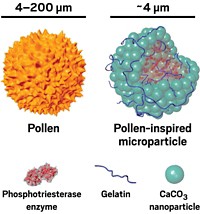Advertisement
Grab your lab coat. Let's get started
Welcome!
Welcome!
Create an account below to get 6 C&EN articles per month, receive newsletters and more - all free.
It seems this is your first time logging in online. Please enter the following information to continue.
As an ACS member you automatically get access to this site. All we need is few more details to create your reading experience.
Not you? Sign in with a different account.
Not you? Sign in with a different account.
ERROR 1
ERROR 1
ERROR 2
ERROR 2
ERROR 2
ERROR 2
ERROR 2
Password and Confirm password must match.
If you have an ACS member number, please enter it here so we can link this account to your membership. (optional)
ERROR 2
ACS values your privacy. By submitting your information, you are gaining access to C&EN and subscribing to our weekly newsletter. We use the information you provide to make your reading experience better, and we will never sell your data to third party members.
Materials
Sticky nanopollen particles pack an antibacterial punch
Silica particles that mimic the rough surface of pollen grains increase the potency of an antibacterial protein
by Alla Katsnelson, special to C&EN
June 13, 2016
| A version of this story appeared in
Volume 94, Issue 24
Supersticky nanoparticles that mimic the shape of pollen grains can deliver lysozyme—a protein found in tears and saliva—directly to bacteria in lab tests, boosting the protein’s antibacterial potency (J. Am. Chem. Soc. 2016, DOI: 10.1021/jacs.6b00243). To make the particles, Chengzhong Yu of the University of Queensland and colleagues first created a polymer core and then coated it with a layer of silica mixed with the same polymer. Burning away the polymer left a hollow silica particle with a spiky, negatively charged surface to which the positively charged lysozyme molecules could stick. When naked spiky particles were incubated with Escherichia coli bacteria, almost 10 times as many adhered to the bacteria as smooth silica nanoparticles. Then when loaded with lysozyme, the spiky nanopollen particles completely inhibited bacterial activity for three days in culture, whereas smooth particles or free-floating lysozyme failed to fully inhibit bacterial growth. Yu’s team plans to test the lysozyme-loaded particles in place of antibiotics in animal feed as a way to combat the problem of antibiotic overuse in factory farming.





Join the conversation
Contact the reporter
Submit a Letter to the Editor for publication
Engage with us on Twitter